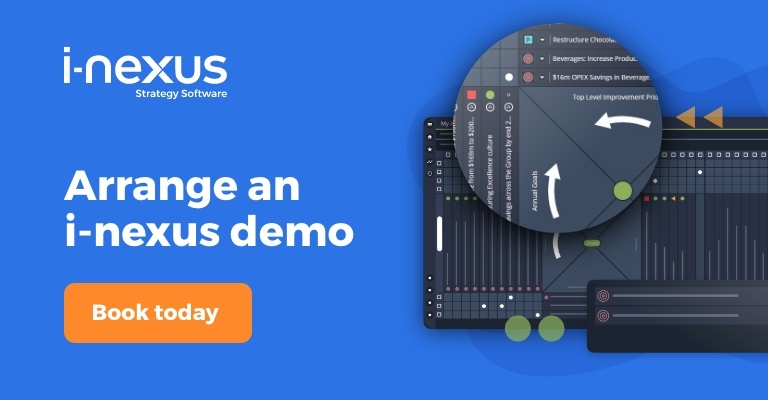With the decade off to a tumultuous start, businesses across the globe have scrambled to adapt their strategic direction, but the good news is that there are software platforms built to help you succeed, whatever the direction you take. Here’s all you need to know about building the business case for adopting a Strategy Execution Management (SEM) platform.
Written by: James Milsom, Head of Marketing
There is little to say about the start of the 2020s which hasn’t been said yet, but what is fair to comment on is the reality that every business leader has been tasked with, regardless of past performance, being agile in adapting and executing their strategy.
Doing so requires a potent cocktail of strong leadership, company-wide alignment, creativity, patience, and the right resources.
And while most of those ingredients will be within the possession of your organization, the crux of the issue is whether you have the right resources.
We’ve spoken before about the importance of focus and reducing complexity within initiatives, but the COVID-19 pandemic has brought this matter to the forefront.
Reduced presence in offices, factories and in the field, the very real threat of contracting the virus, and dipping buying confidence – all signs point to a need for something different.
But where does that begin?
Today we’re covering how you can look to introduce Strategy Execution Management software into your business to support your effort.
From reminding you of the importance of business cases and why you must cooperate across your organization to demonstrate ROI, to building a compelling narrative to justify the investment, you’ll have actionable insights and steps to secure the resource you need to be successful.
Why do you need a business case?
A common failing of projects is that there are unclear requirements.
Whether that is the scope of the work needed, the reasons why it is needed, or the personnel and equity required to execute the project, there is little worse that you can do than attempt to introduce new software without thoroughly justifying it.
The business case is your organizational document, supported by senior leaders, which explains the need for the item in question here, Strategy Execution Management software.
Within the document you should include:
- Executive sponsorship
- Costs
- Benefits
- Risks
- Implementation team
By laying out these clear pieces of information you can be explicit in the need and return on investment of your SEM software. Moreover, with formal approval from senior leaders you have a demonstrable act of commitment to your strategy.
The benefits
By using a business case to introduce SEM software you are ensuring the platform is introduced in a controlled manner, meaning:
- You can align your business and teams to effectively implementing and executing your strategy.
- You involve key stakeholders and your IT team in the process, an active attempt to limit any dissent from IT leaders who believe an internal build would be easier.
- You can easily demonstrate that you have analyzed the problem, potential solutions, and the risks of having or not having SEM software, reaching the conclusion of the need for a solution.
- You will be able to readily show the reason for investment and have laid out the means by which you can measure ROI, making it easier to justify renewal down the line.
And by following these steps, you can ensure that the investment in a Strategy Execution Management platform is the correct choice.
Stage 1 - Define the project scope
Start your business case with a well-defined project scope to demonstrate:
- The need for the software, and
- That the limitations of the project are understood.
What does this mean with SEM software?
In terms of the landscape of vendors available to your business, it is important to think about categories of providers and how they map to your needs. In the SEM space there are categories such as these:
Methodology vendors
These are software providers who specialize at a methodology level and therefore offer you a suite of tools that suit one school of thought. For instance, a project management platform or OKR solution, but will limit your ability to look at the entire Strategy Execution Management conveyor belt.
Pure SEM vendors
There are few vendors available to you who deliver the entire end to end digitalization of the Strategy Execution journey, but i-nexus is one of those.
If you are seeking a SEM platform which allows you to plan, implement, execute and review your strategy’s portfolio of projects in one location, regardless of your methodology, depth of use or the time span of initiatives, you need this type of software.
Enterprise portfolio management vendors
These vendors focus solely on the management of your project portfolio, allowing you to understand their performance and to react accordingly. However, crucially, they do not provide you with the feature set you will need across strategic planning, implementation, execution and review.
Providing you make an informed decision, this will help you to be explicit in your scope about what sort of solution you seek, and if questions arise later about features not included in the software you can refer to the decision detailed in your business case.
What to remember
These are the sections you must include in your business case:
Executive summary
An overview of the goals of the SEM software and its implementation covering key questions such as:
- The business problem you are solving.
- Why it must be solved now.
- Examples of how the problem will be solved with the SEM software.
- The costs (both monetary and human) that will saved – e.g. multiple software licences across the business being consolidated, improving your transformation success rate or supporting hybrid working.
- Revenue growth through the software – e.g. increasing productivity, eliminating the wasted effort of not managing spreadsheets etc.
- Systems integration – e.g. connecting your ERP, finance and CRM software to feed organization-wide data into one location as required for effective strategic governance.
Be mindful to talk in general about vendors at this stage, simply include the above information and be clear about the type of software needed (SEM).
Solution description
Explain how you will use the SEM software to solve the problems defined.
For example, with SEM software you can increase goal alignment by adopting the catchball technique and recording this in the platform, ensuring that all actions, projects and portfolios feed your strategy.
Outline why you are struggling on goal alignment at present, what steps you can take in the future without the SEM software, and how this will be accelerated and improved with the software.
It is also worthwhile explaining your vendor selection process and the considerations given to an internal IT build at this point.
For vendor selection, make use of tools such as Gartner, G2 and booking demos to understand the platforms available to you in more detail.
For your internal IT build, look at the costs involved in building, implementing and managing the platform, as well as hidden costs such as servers, new talent and support. Moreover, leverage (sensitively) past projects to explain why an internal build has not been chosen.
Cost overview
This is where you look to explain the costs involved with the SEM software.
Those costs revolve around the Total Cost of Ownership (TCO) and ROI, which will be investigated in greater detail in stage two of this guide.
The benefits
Pull out a handful of examples of improvements that will come about from adopting SEM software.
They can be tangible such as increasing ROI or driving down errors in your process, or intangible such as boosting morale, driving employee retention and providing alignment. See our blog on the ROI of SEM for more.
Timeline
Outline the timeline for implementing the SEM software solution.
In the case of platforms such as i-nexus, because of the attention to detail and collaborative approach we take to your procurement and implementation, this time can vary dependent on the size of your deployment and organization involved.
In any case, be as clear as you can, and supplement this with project milestones including kick off, testing, go-live, usage reviews etc.
Project governance
Name those staff involved in the project and their roles.
Stage 2: Be explicit about costs
This section is dedicated to looking at the costs involved with the software – you should focus on the Total Cost of Ownership and ROI.
Total Cost of Ownership
It is all too easy to view the cost of the software subscription as the only monetary outlay, but there is more to concern, namely the Total Cost of Ownership. This covers:
- Acquisition costs – the spend involved in introducing the software.
- Operating costs – the spend involved in managing and using the software.
- Personnel/Resources cost – the people involved in using the software.
1. Acquisition costs
Software
Is the cost for the SEM software one-off, monthly, quarterly or yearly? Are there any fees and taxes?
Infrastructure
Will you have to adapt your IT infrastructure to accommodate the SEM software?
Implementation
What is the cost of setting up the SEM platform for it use?
Customization
If you have specific requires from the vendor, what is the attached costs to have these built?
User licenses
How many people will be using the system?
Data migration
If moving platforms between vendors, be sure to understand if there is a cost involved in this task.
Training
Often overlooked as a cost, but remember that training and on-boarding your users will require time and effort to do so. What will be required and does the vendor offer tools to speed up the process, such as i-nexus and the digital training tool WalkMe which offers tutorials to keep training costs to a minimum.
Development
If you would like to connect your CRM, ERP, finance and other systems to the SEM platform, is there a charge for doing so or is there an API or secure file exchange available?
2. Operating costs
Additional user licenses
If your deployment is at only one level, or perhaps two, or your transformation team grows, so too will your user count. What is the licensing model the vendor applies and what is the cost for extra licenses?
Ongoing training
Depending on the form of training offered, this can become costly if it is on-site or outside the Statement of Work. Vendors such as i-nexus provide in-person training, as well as WalkMe digital walkthroughs and in-platform support documentation.
Support and other user/admin costs
What level of support is free and what is the quality of resource? Do you need to hire a full-time employee to manage the software, and is there an additional cost for 24/7 support?
Downtime
Vendors such as i-nexus offer 98% uptime, but does your vendor? It’s always important to think about the costs associated with not having the software and what that downtime can mean for your productivity.
Security
Does the vendor adhere to international security standards such as GDPR and is ISO/IEC 27001:2013 compliant? What is the cost of the security failing if not?
3. Personnel/Resource Costs
Expert Users
How much time will be taken out of your users’ daily activities?
Expert Users are a core part of on-boarding and driving user adoption of SEM software.
Return on Investment
This can be challenging to define, but by explaining the numbers around your projection, benefits and the costs, you can guarantee those who are approving the investment the fact you have used best endeavors.
To calculate ROI, firstly figure out the financial gain of the SEM software minus the cost of investment, and then divide this by the cost of investment.
However, do not forget that there are ways to demonstrate the value of SEM software beyond money.
Stage 3: Secure stakeholder support
As with any project, it is important to map out the stakeholders involved in introducing and using the SEM software, and collaborating with them on the business case.
By doing so you can ensure you identify potential potholes or challenges that you may have not without their support.
Furthermore, the more stakeholders supporting the SEM software, the greater the support you really have for your strategy.
Stage 4: Analyze and compare vendors
1. Get to know the vendor
Choosing the right platform comes down to many of the factors above, but there is also a need for cultural fit. So, naturally, get to know the vendor and don’t rush into a decision.
Consume their content – be that attending a webinar, downloading an eBook, sitting in on events where they are presenting, it all demonstrates their knowledge and the type of people you will be buying from.
2. Book a demo
Once you are familiar with the vendor and consume enough content to understand who they are and their values, it is only natural to take your shortlist of providers and book a platform demo with them.
In the case of i-nexus, we will offer a series of demos which give you an appreciate of the platform and a sampling of your data and strategy sitting in the platform.
You can also preview our platform with our video library:
This is your chance to ask the right questions and be confident that you have all the answers you need as to what your business needs from the SEM software.
3. Read user reviews
Whether it is G2, Gartner, Google, TrustPilot, case studies, or asking the vendor themselves, social proof is a powerful indicator of the quality of product.
Be sure to read and engage with these reviews of the SEM software and factor these into the way that your present the business case. Enthusiasm can be contagious.
Stage 5: Include narrative
If you can present the business case, while following the structure above will go 99% of the way to offering a compelling argument, do not forget that narrative is a powerful tool in your arsenal.
There are an abundance of statistics and arguments that can be made about why businesses all too often fail with their strategic transformation, and we recommend you begin with our blog ’11 reasons you are finding Strategy Execution Management challenging’.
Many of the challenges in that list, particularly around technology and misalignment will strike a chord with your audience.
And don’t forget to ask the vendor for support. Providers such as i-nexus will work with you to project ROI and benefits, along with giving extra weight to the overall narrative.
Is it easy to build the business case?
Building the business case requires your organization and key stakeholders to collaborate on what can be a transformative software investment.
However, much like your Strategy Execution Management, you must approach the building of your business case with the same rigor and discipline.
Provide statistics, calculations and arguments which illustrate the point that you are well aware of – strategic transformations fail more than they succeed, and it takes the alignment of your people, processes, products, and resources to achieve the breakthrough targets which have been set.
And your resources will remain limited in their efficacy without the introduction of SEM software.
Learn more about Strategy Execution Management
Click here to visit our strategy execution knowledge hub, filled with content to support you in embracing the 'no normal' of strategy in the 2020s and beyond, or explore these recommendations:
- Demo the i-nexus SEM platform: Book your own demo of the i-nexus platform to see how our SEM software will transform your transformation program.
- Strategy Execution Management and the conveyor belt process: Read our overview on mastering the three elements of strategy.
- Adaptive Strategy - the future of delivering strategic value at pace?: Watch our latest webinar addressing the future of strategic planning, program deployment and portfolio optimization for value delivery at pace.
About the author
James Milsom is Head of Marketing at i-nexus. James has wide-ranging experience of markets such as telecommunications, energy, education and software.
As Head of Marketing, his drive is to raise awareness and understanding of the challenges facing enterprises in delivering strategic objectives and transformation amidst changing markets and the obstacles traditional tools and methods present leaders.
If you’d like to talk more about Strategy Execution, reach out to James on james.milsom@i-nexus.com or connect with him on LinkedIn for the latest insights.



